Learning about Royapuram

Suma Padmanabhan sharing her memories of a 1962 storm and the story of a ship that sank off Royapuram.
When you have a group of 50 enthusiasts looking to learn about the locality in the northern part of Chennai – which has been “heard” more of but not “visited” – and a person like Sriram V. who leads it, what you get is an outstanding educative tour with lots of fun and learning!
And what is nice about these walking tours is that it brings people together to learn the history of the city’s oldest neighborhoods and, more importantly, the information and conversation which gives an insight and discovering hidden treasures.
Places covered: Royapuram railway station – the first railway station of South India opened in 1856 and which is the oldest surviving railway station in India.
St. Peter’s Chruch built in 1799 by the local boatmen/fishermen residents and consecrated in 1829. It is popularly called “Madha kovil” and has four Mada Streets around it. Royapuram derives its name from St. Peter, who was referred to as “Rayappar” in Tamil.
Royapuram was also a principal suburb to the Parsi and Anglo-Indian community and the next stop was the Parsi cemetery – Anjuman Bagh – and the close by Parsi fire temple – the Jal Phiroj Clubwala Dar E Meher, where only Parsis and Zoroastrian Iranis are admitted into the sanctum sanctorum. This temple celebrated its centenary in 2010.
A brief walking tour followed, getting to know the streets of Royapuram – Maniyakara Chaultry Theruvu, via Lying-in Hospital, leading to the dargah of Hazarath Sheik Kunangudi Masthan Sahib, a sufi saint who visualised God as a female entity in his prayer songs and inspired Bharatiar to write “Kannamma” themes!
Robinson Park, a legendary park, now named Arignar Anna Poonga, is the place where DMK was founded.
All in all, an exemplary day!

Listening to Sriram V in the Royapuram station platform.

At the dargah of Hazarath Sheik Kunangudi Masthan Sahib.
– Sreemathy Mohan
The return of Unni
When V. Ramnarayan spoke at a meeting organised by the Association of British Scholars during Madras Week on ‘Cricket, Carnatic Music and Coffee’ – a tale to be told in these pages one of these days – he responded to an introductory reference to the writings of Cardus on cricket and music, K.N. Prabhu on cricket and English literature, and N.S. Ramaswami on cricket, literature, history and archaeology, saying that he had written an article on P. Unnikrishnan for the Economic Times Sunday supplement in December 2000 using cricketing terms to describe a Music Academy concert of his. “In my opinion, the concert marked Unni's return to form,” he added.
Every seat has been taken at the Music Academy auditorium in Chennai. The December season is at its peak and today’s vocalist is a star of the Carnatic music scene – one of its biggest crowd-pullers, thanks in part to his success as a film singer.
Today, I am waiting with bated breath for Unni to open a bagful of pre-Christmas gifts. This is Test cricket at its best. The venue is the Lord’s of Carnatic music. There is an air of expectancy very much akin to the tension of the first morning of a Test match. Handsome applause greets Unni and his team as the curtain goes up.
My instinct was right. Here’s a rejuvenated Unni, back at his best. Nicely warmed up with the Nattai varnam, his eye in, he plays some delicate strokes in the Charavakam piece, like a wristy batsman relying on timing rather than brute power. His defence is sound, and he is rotating the strike well, enjoying great rapport with his accompanists.
By the time Pantuvarali comes round, he is really middling the ball, presenting the full face of the bat. Dhanyasi is a poem, elegantly executed, the strokes still flowing essentially in the V, no tickling to third man, no paddling to fine leg. The voice is now open, rich in glorious akaram. Nayaki is gentle and mellow. The batsman is now past his fifty and taking fresh guard.
Suddenly he plays a flurry of typical one-day strokes, with a brief Padavini, but is back to serious Test match business, as Sankarabharanam unfolds in its majesty. Now he is cutting and pulling too, with courage and technical perfection.
Completing a well-earned century, Unni is back on the field with a brilliant ragam-tanam-pallavi in Kiravani. Once a close-in fielder and occasional wicket-keeper, Unni now proves he is just as good in the outfield. He chases, dives and slides, throws accurately like the best of them, as melody and rhythm merge in a perfect blend.
At the end of the concert, we come away knowing that the prodigal son has returned. He is as good at Test match cricket as he is in one-day internationals.
Here’s a champion who has learnt his lessons from cricket. I am convinced his cricket discipline helped Unni make this marvellous comeback. Cricket teaches you to take the ups and downs of life with equanimity. It helps you to deal with criticism and make course corrections if warranted.
In short, it gives you that invaluable quality, the sporting spirit. Well played, Unni!
Why Madras is special to Indian cinema
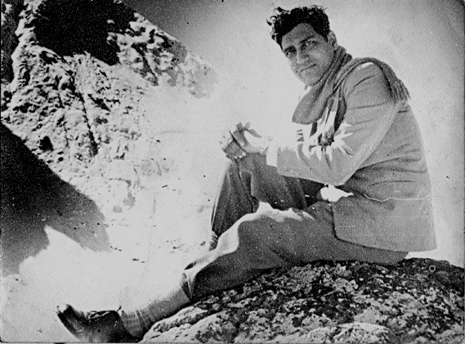
Kodak Krishnan
Several little-known facts and insights on Indian cinema and Madras cinema came to light at a talk given by K. Hariharan, director of the L.V. Prasad Film & TV Academy, as part of the Madras Week celebrations. He was addressing a joint meeting of the Rotary Clubs of Madras South and Chennai Coastal.
Hariharan said that as we celebrate 100 years of Indian cinema this year, we should bear in mind that cinema preceded industrialisation in India and is therefore one of India’s first industries. When Dadasaheb Phalke showed Raja Harischandra in Bombay in 1913, the industry was in its infancy. People saw skyscrapers and aircraft in movies before seeing them in real life. In this respect, India differed from the West. When the Lumiere Brothers exhibited the world’s first film in New York in 1895, industrialisation had begun already. Automobiles created traffic jams on roads, skyscrapers pierced the sky, planes were ready to fly. Cinema arrived in the West as the bridesmaid of capitalism, to deliver the goods of capitalism.
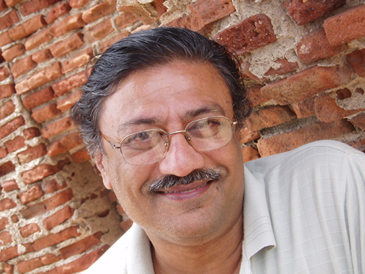
K. Hariharan
In India, not merely did cinema precede industry, it also heralded political change. Mahatma Gandhi came back from South Africa, India’s freedom movement began, and the clouds of World War I gathered. Cinema came to be associated in India with ferment and protest and rebellion and freedom. It was a voice of the people, a tool of dissent and protest, an instrument of democracy and popular culture. It was not seen as an art form that merited patronage.
After independence, India inherited three corrupt systems from the British – a corrupt political system, a corrupt legal system, a corrupt police system. Indian movies targeted all three. Politicians, policemen and lawyers figured as bad characters in Indian movies – they were castigated or lampooned, unless the hero played one of these characters. Our heroes berated existing systems and called for change.
This is perhaps one reason why Government saw film-makers as trouble-makers and mischief-makers, not as pioneers of an art form, said Hariharan. “Every Tom, Dick and Harry is making films,” leaders said disparagingly. They didn’t remark that every Tom, Dick and Harry was making steel or leather. Result: Indian cinema suffered neglect, even ill-treatment from the Government and the corporate world. Centres of learning like the IIT taught everything from naval architecture to civil engineering to paper technology to leather technology, but not film technology. The Government set up a Sahitya Akademi to encourage literature, a Sangeet Natak Akademi for music and drama and dance, a Lalit Kala Akademi to encourage painting, but there was no talk of a film academy.
What the Government did do was to set up the S.K. Patil Committee to probe the ills and evils of the film industry. This committee turned in an atrocious moralistic report. Another committee recommended nationalisation of the film industry, a move supported by film critic Marie Seton who was close to the Government. She said the Soviets had nationalised their film industry. Fortunately India gave up this disastrous idea because the IAS pointed out that Government did not have expertise to manage the film industry.
In 1954, Dr. B.V. Keskar, then Information Minister, banned film music from All India Radio. Radio Ceylon benefited from this; all of India listened to its broadcast of Hindi film songs. The every-Wednesday ‘Binaca Geetmala’ became the rage and acquired cult status. Wiser counsels prevailed in the country after a few years, and film music returned to AIR, dramatising the fact that you can’t ban popular culture.
Hariharan highlighted two unique features of the Indian movie industry: Unlike other countries where Hollywood movies dominate theatres, Indian cinema is wholly indigenous. Our movie industry depends almost entirely on Indian movies, and they come in many languages – Hindi, Tamil, Telugu, Kannada, Malayalam, Bengali, Punjabi…India makes more films than any other country in the world. India is the world’s best movie audience, because its 1.2 billion people love cinema. The Indian nation is in fact a cinematic imagination. People grow up with memories of cinema, its stars, its singers and songs.
Its size apart, India’s movie industry is a great tool of national integration and brings communities together like no other industry. You are a Hindu; but sitting next to you in a theatre could be a Muslim, a Sikh, Parsi, a person from any State in India. Vyjayanthimala brought South India to the homes of North Indians. Amitabh endeared North Indians to the South.
Hariharan pointed out a little-known paradox. Despite the 1,100 movies made every year in India (by far the largest number in any country), despite the 13,000 theatres and 1,400 recording studios and 25 laboratories, the annual financial turnover of the industry is modest – barely US $ 1.2 billion or about Rs. 8,500 crore. “This makes the film industry a pipsqueak industry,” Hariharan asserted. Individuals in India command a higher net worth. During his lectures in the US, he discovered that any book on world cinema devotes barely ten pages to the world’s largest movie producer. Five pages go to Satyajit Ray, a few pages to Adoor Gopalakrishnan and Shyam Benegal, a few lines to Bollywood. There may be some mention of Rajnikanth or Kamal Haasan.
Had either the Government or corporate India been more enlightened in their attitude to movies, the Indian film industry today could have been a giant industry, something all of India would be proud about, said Hariharan. It could have been a formidable world player in art, education, commerce and entertainment, a huge creator of jobs and incomes and revenues for the Government, a source of global prestige.
Hariharan said that though Bombay is described as India’s film capital, it’s actually Madras that merits this label. When cinema arrived, Madras Presidency was the largest presidency in India. It was Madras that gave birth to such fine cinema entrepreneurs as S.S. Vasan, L.V. Prasad and A.V. Meiyappan. The ungainly-looking Sandow Chinnappa Devar was a genius. His films starring wildlife were hits nationwide. Devar could make films for the Tamil audience and for a national audience. Stars come from all over India to work in Madras.
Madras had pioneered the colour era in movies, Hariharan said. He pointed out that his own father, then vice-president of Kodak, had made a huge contribution to the film industry in India through the manufacture of colour negative film. Kodak Krishnan was a household name in the movie industry.
He said the biggest problem in Madras today is that of distribution. Because of piracy – pirated copies of a film begin to spread soon after its theatre exhibition – even an ordinary Tamil film has to spend a minimum of Rs 2 crore on publicity; it has to release simultaneously in at least 120 of the 900-odd theatres of Tamil Nadu, else it can forget the idea of profit. Compounding the problem is the fact that film distribution in Tamil Nadu is controlled by a few players who lay down the law to serve their own interests.
The solution to the distribution problem lies in DTH (direct satellite telecast to home), Hariharan said. Kamal Haasan tried this for Vishwaroopam, but failed because of opposition by distributors. Through DTH, you can watch a new movie on your TV set from the convenience of your own home. You’ll end up spending much less money – you’ll save on cinema tickets, you’ll save on transport and popcorn and soft drinks and junk food!
Hariharan said that the future of cinema lies in information technology. The IT industry ought to take up cinema. Reason: the immense potential of Internet and Youtube and mobile and hand-held media such as cell phones and I-Pads for dissemination of movies. This could herald a phenomenal change for cinema. This development is inevitable, Hariharan thought.
-S.R. Madhu
Without Reserve
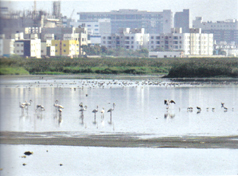
The birds still find a place at Pallikaranai despite development towering over them.
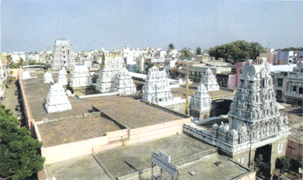
A rare view of Sri Parthasarathy temple, Triplicane.
A surprise participant in this year’s Madras Week programmes was the Reserve Bank of India’s Chennai Region office which organised several events. An even greater surprise to this Madras Week correspondent, who was present at one of the events, was the Bank’s house journal, Without Reserve, which he found one of the best in the country, whose July-September issue – conscious or not of Madras Week – carried two features on the city.
One was a photo-essay shot by the office’s photographer of Madras’s landmarks. It was titled An Evening in Parry’s and included over a score of brilliantly shot (and printed) pictures, a couple of which we present here. The other was a feature written and photographed by Nalini Sankaranarayanan, an officer of the Bank. Her Brushed by Feathers featured here gives readers a peek into the wild life of Madras.

One of Madras's feathered visitors.

A view of Kalakshetra from a balcony.
The uninhibited role of youths
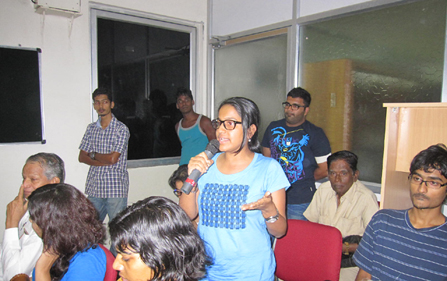
Active participation by youth at the seminar on the Madras Press held at the Indian Press Institute.
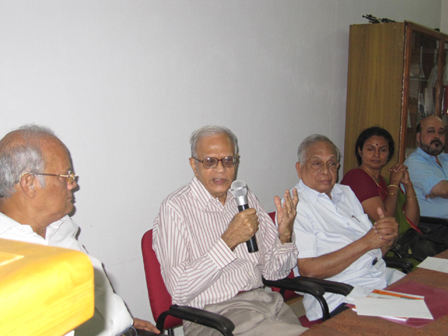
Panellists discussing the Madras Press at the Indian Press Institute. From left to right: R.V. Rajan, S.R. Madhu, S. Muthiah (Chair), Dr. Jaya Sreedhar and Shreekumar Verma.
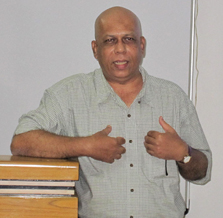
Harry MacLure introducing his film Going Away.
Madras Week this year (August 18-25) more or less settled into being Madras Fortnight and promised to become Madras Month, with more than 100 programmes/events/happenings across the city.
This year was particularly memorable for Harry MacLure, comic book illustrator, cartoonist, graphic designer, magazine editor and publisher. His film, Going Away, was screened to houseful audiences at the Press Institute of India and the Madras Club. The film, set in an Anglo-Indian milieu in St. Thomas’ Mount, is about a fictional Anglo-Indian family coming to terms with the possibility of emigration to Australia and having to leave loved ones behind here. The Anglo-Indians – A 500-Year History, a book that is a must-buy for all those with more than a passing interest in history, authored by S. Muthiah and Harry, was also released during the week before an audience of nearly 300 persons.
* * *
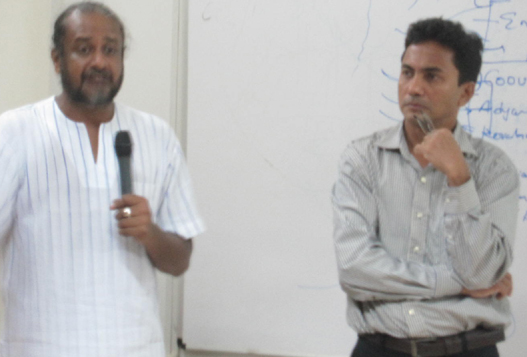
Nityanand Jayaraman and photographer Shaju John (right) discussing garbage and Chennai's vanishing wetlands at the Indian Press Institute.
One of the high points at the Press Institute (there wasn’t even space to squat on the floor) was when Nityanand Jayaraman made a presentation on Chennai’s vanishing wetlands and its consequences. Development is all fine, he said, but not at the cost of destroying nature or by upsetting its laws. His presentation was complemented by some moving pictures (mostly depressing in the second part) taken by Shaju John, a well-known freelance photojournalist.
I finally breathed a huge sigh of relief when the final programme at the Institute went off without a hitch. Moderating a controversial subject, ‘Madras newspapers – the good, bad and ugly’, was S. Muthiah. The speakers discussed various issues confronting journalism today – paid news, corporate ownership of newspapers, credibility, citizen’s journalism, advertising and the commercial aspect, as well as the quality of the fare on offer.What was best about this get-together was the uninhibitedness of the college students from various media courses who plunged into the discussion.
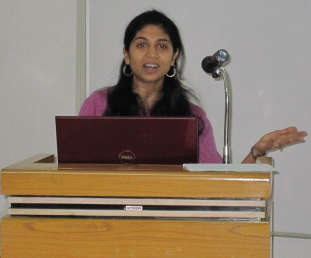
Kadambari Badami making an impassioned plea to youth at the Indian Press Institute.
However, for me, the star during the four days of programmes at the Press Institute was Kadambari Badami, an active member of Transparent Chennai, who spoke about creating a pedestrian-friendly and ‘walkable’ city, through participatory planning, public-government partnerships, citizen empowerment, and the Nanganallur and KK Nagar projects. She made an impassioned plea to the youth in the audience and elsewhere to do their bit for the city and make it more liveable. She even admonished them with a ‘Shame on all of you!’ outburst. It was probably her frustration coming out, finding little support for her initiative from people of her age. More power to her.
* * *
The Pupil Saveetha Eco School, Poonamalle, made a debut in this year’s Madras Week’s celebrations. And what a debut! The school organised weeklong programmes that it collectively styled ‘Madras Memoirs’. There were a series of inter-school and intra-school events and competitions that highlighted the transition of the city from Madraspattinam to Chennai.
The person who made all this possible at The Pupil, almost single-handedly, was Dolly Mohan. She says she initially dreaded taking up the onerous task but as she got into the groove she began enjoying being a part of the old and the new. She’s been in Chennai for more than two decades now but, like many, she was ignorant about how the city had evolved and grown. Once having been entrusted with the responsibility of organising the events at the school, she researched hard and found a magical path leading to the past. In the process she rediscovered a small part of the rich legacy of Madraspattinam. She knew it all amounted to only scratching the surface but she had made a great start. ‘The quiz, the photographs, the relics – everything added to my personal knowledge of Madraspatinam. Wish we had a time machine that would take us back into those days when life was so peaceful compared to the frenetic one we lead today,& rsquo; she says.
What was also significant at The Pupil was that Saveetha, who runs the school, was herself enthused and that enthusiasm helped motivate her team. The school is now looking towards focussing more on history and geography in the lower classes. I would suggest devoting a period to Madras and its history in classes 5, 6 and 7. Nanditha Krishna has already done it at the school run by the C P Ramaswami Aiyar Foundation on Eldams Road, and Mrs. Y.G. Parthasarathy has said that the PSBB Schools would do likewise from the next academic year. All this bodes well for the future.
- Sashi Nai
Converting a dump into a tree park
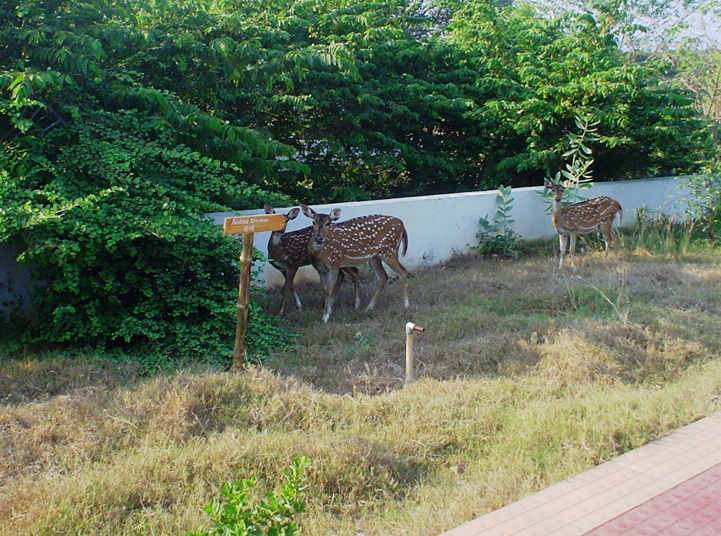
A rare visitor to the Park.
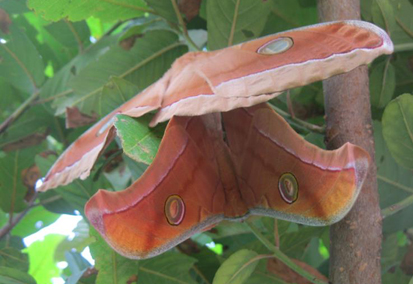
The tussar silkworm on the Arjuna tree, which also has medicinal properties.
“You can be an armchair activist and say ‘the government didn’t do this’, ‘the corporation didn’t do this’. But what have you done?” asked Shobha Menon, founder-trustee of Nizhal, an NGO dedicated to greening urban areas and regenerating biodiversity, speaking during a Madras Week event. Of concern to Nizhal is native trees disappearing from their original locations, as the unique flora and fauna that flourish around these trees also vanish. For example, there is only one Purasai tree (Flame of the Forest, Butea frondosa) in the whole of Purasawalkam, in Gangadeeswarar Temple.
This concern led to the formation of Kotturpuram Tree Park through a persevering voluntary effort led by Shobha. And it was the heart-warming story of this Park that she narrated in her talk. Nizhal activists and willing volunteers, aged from three to seventy plus, developed the Park sapling by sapling, literally. After six years, the Park today is home to more than 400 trees belonging to over 100 species and teems with a diversity of insects.
Shobha had been writing on civic affairs for long and her vision of long-term care for trees “that supply us oxygen” led her to found Nizhal. In early 2008, a proposal came to Shobha from the Superintending Engineer of the PWD, who knew of Nizhal’s work, on doing something about the five-acre area of wild growth on the banks of Adyar river opposite the Madras Club. Situated on one side of River View Road, Kotturpuram, the area had earlier been used as a dumping yard. A small volunteer group was formed, under the guidance of the first Chief Urban Planner of the Madras Metropolitan Development Authority, the late G. Dattatri, to develop a tree park. “We were excited about the prospect of bringing back local trees,” recalled Shobha. The PWD, which proposed the Park to mark its 150th year, did not have funds and wanted the local citizens to maintain the Park. The Park project, therefore, became a voluntee r-driven effort and activism of a persuasive kind won Shobha support from many, including the government.
To give a local flavour, saplings from Tiruvannamalai and Auroville, which had evergreen tropical dry trees, were brought in to begin the project. These included Tannaku, Purasai, Veppalai, Karuvaali, Konji, Ulakkaipalai, and Kuttippirai. Community support as expected was not forthcoming initially and the volunteer group started with pitting a small area just after the monsoon in 2008. As only one hand pump in one corner was available as a water source, the saplings were planted in batches of ten. Summers were testing times due to water scarcity. Dattatri proved to be a “godsend” when things weren’t moving and helped Shobha tide over low phases.
Four months later, volunteer support gradually built up. Funds were in short supply and the team had to fight limited physical resources as well. Every possible citizen, be it a child playing cricket in the vicinity or a senior citizen, who came to the park to walk, was roped in as a volunteer. Large volunteer support was needed to water the saplings and extend the area of tree cover.
After four years, with the park sporting exquisite growing stalks, Chennai Corporation laid walking paths. By now, wheel barrows were used by volunteers to transport water from one end of the park to the other. The swelling volunteer numbers, comprising school-children, college students, corporate volunteers, and senior citizens, continued to contribute their wholehearted support. “This was not ad hoc volunteerism,” stressed Shobha. She commended volunteers from the core team of Nizhal (Dr. Babu, Swaminathan, Latha) and a few young volunteers (like Gajendran and Vinod) who came and helped to meet whatever the Park needed. Even Shobha’s mother, Thangam Menon, became an enthusiastic volunteer as was another septuagenarian neighbour, Radha Padmanabhan. Walkers began to throng the park and, a few months ago, active members from among the volunteers formed the Friends of Kotturpuram Park, which was registered as a soc iety.
Poochi Venkat, the macro photographer who works on insects, discovered many insect species in the Park that the volunteers didn’t know of. Standing tall in the park are Arjuna trees (Termilnalia arjuna) and a Wheeler tree (Albizia amara). Another attraction is the Helicopter Tree (Gyrocarpus americanus). Shobha was excited to see the tussar silkworm on the Arjuna tree, which also has medicinal properties.
Shobha is happy that students visiting the park learn the value of sustained action. “The idea is to inspire more urban biodiversity parks,” she said. Her activism has demonstrated how a caring citizen can make a difference. She regretted that some people have a mental block when it comes to getting involved with public spaces. She exhorted citizens to contribute in any way possible to improve their own neighbourhoods.
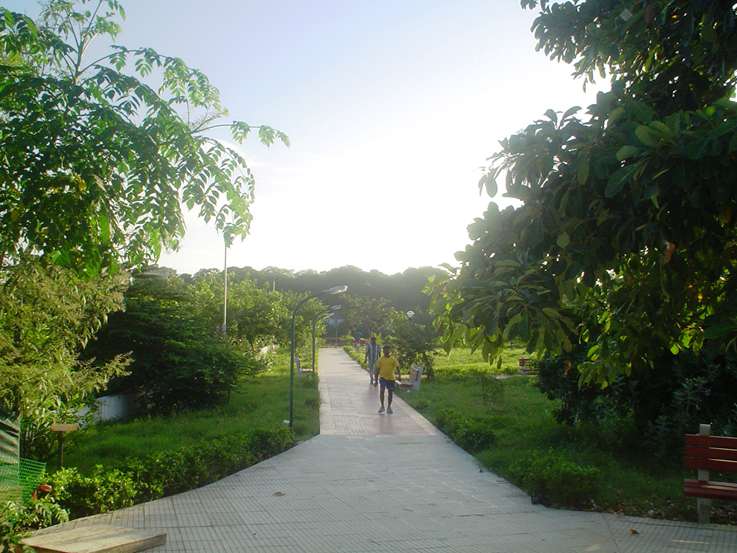
A view of the Park.
– K. Venkatesh
SOS Village looks at temples
I had heard of SOS Village near Tambaram and the great work it has been doing since 1979 for children who, unfortunately, had no family support or protection. I had wanted to visit the place for long and when I was invited to deliver a lecture as part of their Madras Week celebrations, I was only too happy to do so. I had no idea it would be a learning experience for me.
I didn’t earlier know that this home for children was spread across a vast expanse of five acres. Nor did I know that those children lived in groups of five or six in beautiful little houses, each unit with a hall, kitchen, bedrooms and bathrooms. Each home is run by a woman who is like a mother – ‘amma’ to the children – who buys groceries, cooks for them, helps with their homework and generally does everything a real mother would do. Backpacks arranged in a row, stuffed toys, a ‘happy birthday’ poster made for one of the children by others in a house – these were some of the signs I saw of a happy home and those of little boys and girls from diverse backgrounds, bonding and growing up together as brothers and sisters. There were cheerful faces all around making it obvious that the children have moved beyond a difficult past. A little temple for Lord Ganesha finds a place near the office and it is he re that many of the children who had grown up in SOS Village come back to get married after completing higher studies and securing good jobs.
Lectures, music recitals, dance performances and all such functions are held in the auditorium, a beautiful structure in the centre of the SOS village, designed like a Koothambalam found in Kerala temples and even reminding of the Kalakshetra auditorium in Chennai. The very peaceful and calm setting here is enhanced by the greenery all round, including a big banyan tree near the entrance. The chirping of birds, hardly any traffic – what a pity children in the city mostly don’t get to experience anything like this either in schools or around their residences!
I spoke among the students and the adults there about the temples of South India with a special mention of those in Chennai – about their antiquity, sculptures, architecture and valuable inscriptions. The lecture focussed on the ancient Chola temple in Madambakkam near Tambaram and the four famous temples of Chennai along the coast – Adipurishwarar temple in Tiruvottriyur, Parthasarathy temple in Triplicane, Kapaleeswarar temple in Mylapore and the Marundeeswarar temple in Tiruvanmiyur. These coastal temples existed in Pallava times and have witnessed architectural growth spanning many centuries.
Many in the audience had visited the Madambakkam temple, fairly close to SOS Village, and so could connect with what was being explained. It was heartening to see their interest in the subject.
Post lecture, there was enough time for interaction and there was a flood of questions – ranging from “Were animals used in the process of constructing temples?” to “How come we are told that the shadow of the Thanjavur temple never falls on the ground?” And the commonly asked query was “How long did it take to build a temple?” which was difficult to answer.
– Chithra Madhavan
Madras Quiz 2013

All the finalists in the Madras Quiz 2013 held at the Ramada Egmore during Madras Week.
The best school team was from P.S. Senior, but it could not make it to the finals which was won by the team of Ramanan Vembu and Ram Kumar Shankar. The Quiz was sponsored by the Murugappa Group.
Rotary Clubs and Madras Week
Madras Week was celebrated by several Rotary Clubs, though under the guise of the “Madras 374”.
The various activities conducted by the Clubs during Madras Week are as follows:
The District Club Service launched its initiative “Madras 374” on August 1st to celebrate the legacy of Madras and also to bring in some fresh air to weekly club programmes. Many Clubs participated vibrantly.
l RCM South conducted multiple activities in the form of a Quiz conducted by S. Muthiah, Heritage speakers held joint meetings to promote Madras. Almost every week they had a programme.
l RC K.K. Nagar conducted quiz competitions and also had a meet on Madras Heritage addressed by Shashi Nair.
l RC Velachery conducted a joint meeting along with RC Thiruvanmiyur on the subject ‘Eminent women of Madras’ addressed by Nina John.
l RC Madras Coromandel conducted the ‘Mylapore Heritage walk’ guided by Dr. Chithra Madhavan.
l RC Chennai Towers conducted a photo competition titled ‘I love Madras’ and also participated in a quiz on Madras organised by RCM South. An SMS-based quiz on Madras was conducted by them.
l RCM Midtown conducted a weekly meeting participated by Gopu who spoke on ‘Chennai Pattinathu Edison’.
l RC Madras Centenary Commemoration held a photo exhibition titled ‘Madras’ at the Pallazo Art gallery between August 21 and 31.
l RCM Central Aaditya held Madras Day celebrations on August 24th.
l RC Anna Nagar Aaditya held a meeting on August 26th where Ramanujar spoke on ‘I love Chennai’.
l RC Madras held multiple programmes to commemorate Madras Week celebrations.
l RC Ambattur celebrated Madras Day along with their Charter Day. They invited and honoured the models who posed for the ‘Triumph of Labour’ statue.
l RC Temple City participated in the Madras Quiz with three other clubs.
l RCM Chenna Patna organised a talk on Natural Heritage of Madras.
l RC Royapettah organised a dinner and fellowship meet to celebrate Madras Day and they conducted a quiz and Rtn.Kishore Kumar gave a speech on ‘Madras and its heritage’.
l RCM Ashok Nagar conducted a Family Fellowship dinner night and conducted a Quiz on ‘Singara Chennai’.
|

